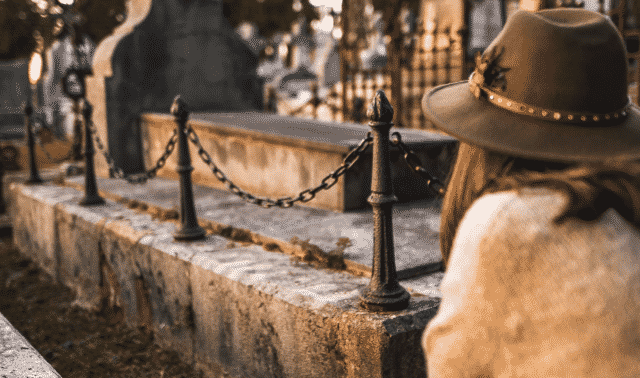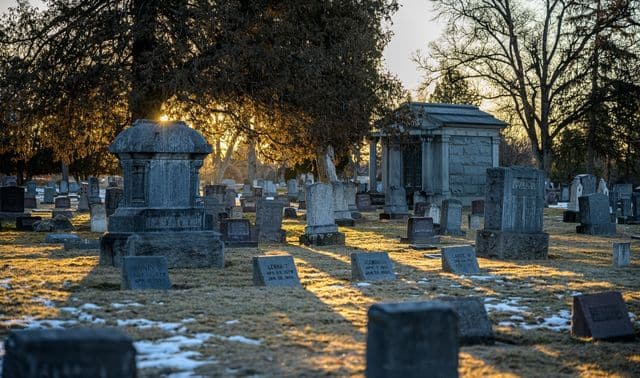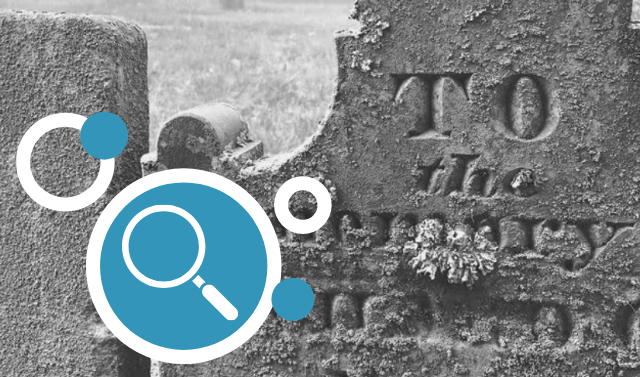Sign up for the Family Tree Newsletter! Plus, you’ll receive our 10 Essential Genealogy Research Forms PDF as a special thank you.
Get Your Free Genealogy Forms
"*" indicates required fields
Admit it. Who among us has not included an impromptu stop at some cemetery during a road trip or family vacation? As genealogists, scouring cemeteries near and far is longstanding practice, even if at times it’s tricky to justify to our travel companions (“We’re going where? To see what?”) Sometimes our interest in cemeteries carries beyond our own family history, and we take interest in the burial sites of others, including famous locals and other notable people.
This type of travel is now jokingly referred to as “tombstone tourism,” but it is not a new concept. For centuries, people have made journeys to the burial sites of ancestors, religious icons, celebrities, heroes and leaders. For example, since the Middle Ages, people have made pilgrimages to visit the burial places and shrines of saints to venerate their remains or pray for intercession and assistance. In the 19th century, park-like garden cemeteries exploded in popularity. These cemeteries encouraged visitors to walk, picnic and socialize while they honored the dead. Finally, modern holidays like Día de los Muertos (Day of the Dead), celebrated in many South and Central American countries, involve honoring the deceased by visiting gravesites.

Are you interested in planning an entire holiday trip around visiting a particular graveyard of interest? Do you wish to travel long distances to see a specific burial site? What do such trips cost, and what do you need to ensure a successful trip? Fortunately, I cover all of these concerns below.
Why Travel to a Cemetery for Genealogy Research?
A visit to a family burial site is like traveling back to another place and time. No transcription or photograph can replace standing on the ground where your ancestors once stood and where they are now buried. You may choose to travel to the cemetery for other reasons, perhaps to find a bit of history or locate the burial place of some celebrity. But once there, you will become aware of many other benefits of visiting a cemetery.
Many people are intrigued by the scenic vistas, silent acres of tombstones stretching across the distance or even the isolated peace of a small rural graveyard. Others appreciate the stone carvings, artwork, symbols and statuary of the monuments and, in the case of mausoleums and crypts, the architecture.
Regardless of what draws you to the dead, cemeteries are excellent resources to genealogists. Tombstones and other memorial markers can provide useful details like names, dates, places, relationships, birthplaces and even military status and community service involvement.
Strangely, the cemetery can also be a place to meet fellow visitors. You might even learn something about the history. And be sure to seek out the caretaker or sexton who likely can provide you with constructive advice and useful information.
How Do You Know Where to Go?
Of course, once you arrive at the cemetery, you may wonder: “Now what? Where do I go from here and find the person I’m looking for?”
To locate where ancestors are buried, you might:
- Check with family members. Start your search simple by asking relatives if they know where ancestors are buried. Then, you can plan your trip around that information.
- Study death certificates. Before you even get to the grave, you can glean a lot of information about ancestors just by reviewing their death certificates. For example, death certificates will often reveal where the death took place (the jurisdiction) and the date of death. All of these clues can be handy as you scour the cemetery for more discoveries.
- Seek out obituaries. Obituaries offer the perfect glimpse into your ancestor’s death. They often reveal who your ancestor was as a person, as well as who their family and friends were.
Tips and Tools for a Successful Cemetery Visit
There are many reasons to visit a cemetery or graveyard, and as many opportunities to indulge your interest and curiosity. For a successful trip, you’ll want to make sure that you pack appropriately and remember some simple but important tips as noted below.
What You’ll Need
Appropriate Clothing and Footwear
Cemeteries may be quiet places of rest, but they can they provide quite the hike for visitors depending on the weather and terrain. You may have to trek steep hills, navigate around deep mud puddles and wade through tall grasses. Needless to say, you won’t want to wear your Sunday best on your cemetery trip. I recommend checking the local weather for the day of your trip and then plan accordingly. If rain is in forecast, consider packing some durable boots. On the other hand, if it’s more likely to be a blazing hot day, wear lighter colors and comfortable shoes that allow for a lot of walking (and also, don’t forget sunscreen).
Bug Spray
As mentioned above, cemeteries tend to be green and lush and overgrown with all sorts of plant life, which makes them the perfect homes for pesky critters. For this reason, you might want to consider packing bug spray, especially if you plan to stick around later into the evening when the mosquitoes come out in force.
A Camera
You will surely want to take lots of pictures of those worn tombstones and intricately carved stones. The camera on your phone may work for basic “selfies” and group photos; however, if you want to truly capture every crease in the stone and other fine details, you may want to invest in a high-quality camera. Whatever you choose, be sure to review some best practices for taking beautiful, evocative tombstone photos.
Plenty of Water and Refreshments
Cemeteries aren’t your typical theme-park vacation destinations; as such, they aren’t known for having rows of colorful rows of concession stands. Nonetheless, standing in the hot sun and walking around for hours can make you thirsty and hungry fast. Be sure to pack some water bottles and other refreshments, like granola bars and dried fruit. That way, you can explore for a while without having to leave to recharge.
What to Keep in Mind
- Plan ahead to ensure there are no services or events that your visit might disturb. At the end of the day, cemeteries are public spaces that we must share with others. To ensure that you are respectful of others’ observances and grief, be sure to check that there is nothing going on at the cemetery for the day you book your trip. You can find out by visiting the cemetery’s website if they have one or calling the administrative office.
- Be respectful and follow the rules. This perhaps goes without saying, but remember that you are a visitor and must be respectful of both the living people around you and the dead. Rules may also vary from one cemetery to the next. One may allow you to touch all memorials while others may keep some off-limits. You can usually find a cemetery’s rules on its websites and even posted someplace on site.
Tips for Taking a Guided Tour
While planning your cemetery vacation, you may want to look into organizing a tour of the site. Some cemeteries are large, famous or historically significant enough to offer guided tours. These tours may be self-guided with a provided map or headset recording, or may even be a scheduled group tour led by an informed guide who can point out key attractions or direct you toward places of particular interest.

Most cemeteries, however, are small and unable to provide guided tours. Fortunately, that doesn’t have to mean that you are out of luck. You could contact a local historical society or family history group to see if they have interest in providing an impromptu guide. Even contacting the parish or the municipality responsible for the burying ground could connect you with the sexton or caretaker, if they are not working on site, who might provide some interesting facts and details about the history of the cemetery and those laid to rest there.
Pre-planning is key to the success of your visit. Do your research ahead of time so you will not be surprised by any unexpected requirements. Think about how to get to your destination and where you will need to park and how long it will take.
Other Considerations During (and After) Your Tour
- Stay close to the guide during the tour. You will likely have plenty of time to explore. That said, during the tour you’ll want to make sure to stay with your group so that you don’t miss any valuable information.
- Prepare some questions beforehand. Your tour guide will likely have a wealth of information to share, and this is your opportunity to get that information! You might consider brainstorming several questions before the tour and writing them down someplace so that you don’t forget them.
- Consider tipping the guide or donating to the organization that oversees the tour. Local organizations and historical groups can always use some outside support. If you have the means, you might donate a couple of dollars to the cause to show that you appreciate what the organization has to offer.
Traveling Abroad for Tombstone Tourism
Your travel plans might entail visits to cemeteries and burial sites across the country or even the globe. For those particularly long distance trips, many travel agencies, both domestic and international, may offer group tours that include organized and scheduled cemetery excursions to historic sites and celebrity burial places. If the travel agent is unable to include these plans, you will need to do some research of your own in order to add these tours to your travel agenda. Below I highlight some popular heritage travel websites, as well as popular tombstone tourism destinations.
Where to Book Your Trip
ProGenealogists from Ancestry.com is one online option that offers one-of-a-kind private guided heritage tours to ancestral home sites, including cemeteries. Ancestral Footsteps is a unique company that will conduct family history research and then organize a tour led by an in-house researcher to present your family story in the actual heritage locations. Travel Your Tree can assist in researching your family history and planning your own personal heritage tour. Finally, services like My China Roots and Ancestral Attic target travel to more specific ethnic and religious communities.
Apart from visiting family homelands and hometowns for your family history, many places around the world are well-known for their cemeteries and the significant individuals buried there. Many of these world-famous places offer tours, which you can arrange yourself or with the assistance of a website like Tripadvisor. Tripadvisor also offers multiple tour options that include historic walking excursions and even expeditions by bicycle, golf cart and tram where available. You can even choose tours that occur at specific times of the day, evening and even nighttime with candlelight or other themed tours. Also find details, prices and useful suggestions for the journey.
Destinations in the United States
Arlington National Cemetery in Virginia is one example of a large and distinguished cemetery, spread over almost 640 acres. Many military personnel and other national notables from astronauts to presidents are buried there. Across the country in Los Angeles is Hollywood Forever Cemetery where there are numerous monuments belonging to many different celebrities, from musicians to movie stars and even little Toto from The Wizard of Oz.
Destinations in Canada
In Canada, Toronto’s Mount Pleasant Cemetery is one of the largest and most well-known cemeteries, and the final resting place of many prominent Canadians from musicians to writers, businessmen and even a prime minister. They say a visit here is like a tour through the city’s history.
There are also the famous Titanic cemeteries located in three Halifax cemeteries where the remains of many were interred after the great ship sank off the Nova Scotia coast in 1912.
Destinations in Europe
Highgate Cemetery in London is renowned for the architecture of its mausoleums, catacombs and tombs in a breathtaking gothic setting. The Cimetière du Père Lachaise in Paris is one of the most famous tourist destinations in the world. This former garden cemetery, the city’s largest, receives 3.5 million visitors each year, perhaps the most in the world. Tourists come to see the final resting place of many internationally famous musicians, authors and actors, as well as the architecture of the multitude of mausoleums and monuments including chapels, a crematorium and columbarium.
Tips for Tombstone Travel Abroad
- Make sure you have a valid passport. If you are planning an international excursion, you will want to ensure that you know where your passport is and that it is up-to-date. Ideally, secure your passport before organizing your trip.
- Plan ahead in detail. Choose the best time of year to visit and do your research so you know what to expect.
- Check your electronics. Laptops and other electronic devices may require adaptable charging cords, depending on the country to which you are traveling.
- Have fun and be safe! Always be safe when traveling away from home. Go with a friend or partner, carry a personal safety alarm or plan to stay with a group.
Virtual Tombstone Travel
Can’t travel for whatever reason? No worries. Technology allows you to explore cemeteries from the comfort of home. It may not be quite the same as a personal visit; fortunately, there are many websites that allow you to view memorial monuments without ever leaving the comfort and convenience of your cozy ergonomic computer chair.
The internet allows enthusiasts to locate specific burial sites and to view posted photographs of the cemetery and of the memorial monuments. Any search engine can direct you to a growing number of sites that are literal digital libraries of cemetery records from around the world. Among the most common are Find a Grave, Interment.net, The World Wide Cemetery and BillionGraves but there are many others as well including Legacy.com, Tribute Archive, Dignity Memorial and CanadaGenWeb’s Cemetery Project. You’ll also discover that there are specific regional and religious websites available as well. And, best of all, most of these sites are free and easily accessible with perhaps only a registration account required.
And, just as in the real world, a metaverse cemetery often allows you to leave digital memorials and tributes of flowers, candles or cards to commemorate your visit and pay respects to the deceased. These remain attached to the memorial for an indefinite period. There is something visceral and profound about visiting someone’s actual resting place in person but many people appreciate these virtual opportunities that provide the ability to visit and pay their respects from the comfort of home.
Tips for Virtual Tombstone Travel
- Check your internet connection. Nobody wants their virtual journey disrupted by lag or unreliable connections. Before you start exploring, you might want to check that your internet speed and stability are where they need to be. You can find speed tests online like this one from Google to see for yourself how your internet fares.
- Make discoveries and preserve them. The beauty of virtual tombstone travel is that you don’t have to carry your heavy electronics around. In fact, your laptop, tablet or PC is your means of transportation. It may also be where you store your research. As you explore many different websites, be sure to create a file where you compile all of your research findings. You never know what you will discover when you look over your notes at an even later date!
Bon Voyage, Taphophiliacs!
The word taphophilia comes from the Greek tapho, referring to “the grave, funeral or tomb”, and philia, meaning “the love of”. Thus, taphophilia literally means a love of the grave, funerals and tombs. Taphophiliacs may feel compelled to visit, record and even photograph cemeteries and memorial monuments. This pastime may also accompany a love for local history or genealogy.
So before your family has a chance to say “We’re going where? To see what?”, you can tell them with confidence that you are not just going to a cemetery. You are going on a time-traveling trip to discover your family history, to be introduced long-lost relatives, to see historical monuments erected in memory of ancestors or even just to admire famous memorial monuments and historical landmarks. How could they resist joining you on such adventures in tombstone tourism?
Related Reads
A version of this article was posted online in October 2023. Last updated: July 2025








